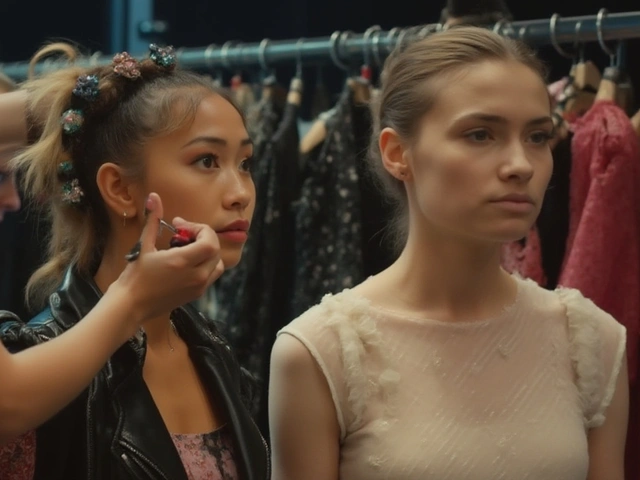You ever feel like you're stuck in a rut with your modeling career? Or maybe you're just starting out, unsure how to stand out in a super competitive industry? Either way, the magic ingredient might be right under your nose: feedback. Yep, taking onboard what others say about your work can make all the difference in pushing your modeling prospects forward.
But don’t just passively accept all feedback. Learn to distinguish constructive feedback from mere opinions. Useful feedback highlights areas of improvement you might not see yourself, whether it's your runway walk, portfolio shots, or networking approach. Actively seeking and applying good feedback can polish your strengths and tackle weaknesses you weren’t even aware of.
So, next time you get a critique, listen carefully. Is there a pattern in what people are pointing out? If multiple sources suggest improving your posing or suggest trying a different style, it might be time to take that advice to heart. Plus, showing you can handle critique with grace and use it to fuel your progress speaks volumes about your professionalism.
- Key Points
- Direct Answer
- Comprehensive Guide
- Feedback for Improvement
- Types of Feedback
- Implementing Feedback
Key Points
Wading through the modeling industry without a guide is like navigating a maze blindfolded. One key way to lift that blindfold is through feedback. Knowing how to properly gather, interpret, and use feedback can set you apart from others vying for the same model jobs.
1. Seek Feedback from Diverse Sources
Feedback isn't just about listening to photographers; it’s valuable to hear from designers, makeup artists, and other models. Each one will offer different perspectives and observations that can help shape your career.
2. Identify Patterns in Feedback
Notice any recurring themes? If three different people point out that your posing could use some work, it's probably a good idea to focus on that. Identifying patterns ensures you're improving in the areas that matter most.
3. Constructive Criticism vs. Just Plain Criticism
Not all feedback is created equal. Constructive criticism aims to help you grow. Learn to differentiate this from empty or unhelpful critique. Remember, ignore the negative without a constructive base and embrace the advice that genuinely aims to improve.
4. Translate Feedback into Action
Knowing what to improve isn't enough. Craft a strategy to put feedback into action. Whether it requires more training, altering your portfolio, or simply fine-tuning your personal brand, actionable steps are necessary.
5. Regular Review and Reflection
Improvement is a continuous journey. Regularly reviewing past feedback helps you track progress and stay aligned with your goals. Reflection isn’t just about what needs work, but also celebrating improvements, boosting morale and keeping motivation high.
Implement these steps and, before you know it, your model career will be on a trajectory toward success.
Direct Answer
If you're looking to enhance your model jobs prospects, using feedback effectively is your go-to strategy. Seriously, feedback isn’t just about getting compliments or being saved from mistakes you didn’t know you were making. It’s about actively seeking out information that helps you grow as a model.
Seek Constructive Criticism
Start by identifying trusted sources for feedback: mentors, seasoned models, or even previous clients. They're likely to offer insights that are both practical and honest. Constructive criticism isn't meant to tear you down but to highlight growth areas you may have overlooked. Recognize it, appreciate it, and most importantly, use it.
Actively Listen
When you receive feedback, it's crucial to listen actively. This means giving full attention to whoever's speaking, understanding their perspective, and not just waiting for a chance to defend yourself. Absorb the feedback without arguing, and trust that it's coming from a place looking to help you improve.
Make it Actionable
Every feedback should lead to a specific action. Think of it like this: if someone notes your posing needs work, book a session to practice new poses. Reflect on feedback, and set achievable goals to tackle improvements one at a time. Keep track of progress, and don’t be afraid to ask for updates on how you’re doing in those areas.
- Model jobs can be fiercely competitive – informed adjustments can make a big difference in your work.
- Feedback won’t just tell you where you went wrong; it’ll tell you how to unfurl your strengths further.
Remember, using feedback effectively can transform your career trajectory. It can be your secret weapon in building a robust and resilient modeling career. Keep seeking it, keep processing it, and keep improving.
Comprehensive Guide
So, you’re looking to amp up your model jobs prospects, huh? Feedback is your secret weapon. Whether you're a seasoned pro or just stepping onto the runway, gaining and using feedback effectively can be transformative. Let’s break it down into bite-sized pieces.
Why Is Feedback Important?
In modeling, details matter. A little tweak in your posture or a slight change in your expression can alter how a photo turns out. Feedback helps you see those tiny details that you might miss. It turns good models into great ones by honing skills, boosting portfolios, and even helping find niche markets.
Getting Feedback
Finding valuable feedback in modeling starts with knowing who to ask. Here’s a list of folks who can give you honest, constructive advice:
- Modeling Coaches: They’ll provide you with targeted advice to improve your skills.
- Photographers: Feedback on posing and expressions can be invaluable during shoots.
- Agents: Often, they know precisely what clients are looking for in your local scene or beyond.
- Peers: Fellow models might share tips from their experiences that you haven’t considered.
Types of Feedback
Not all feedback hits the mark. Here’s what you should look out for:
- Constructive Criticism: This isn’t just pointing out flaws, but providing solutions.
- Encouragement: Motivates you to keep pushing even on tough days.
- Insights: Unique angles or tips that haven’t crossed your mind before.
Acting on Feedback
- Review and Reflect: Don’t rush. Take your time to think about the feedback you received.
- Create an Action Plan: List out skills or areas to improve and set achievable goals.
- Practice and Execute: Work consistently. Whether it’s in front of the mirror, in fashion shows, or photo shoots, practice makes perfect.
- Re-evaluate: Regularly check back with your sources of feedback to track progress and re-adjust your strategies.
Remember, in the world of model jobs, adaptability is key. The industry’s tastes can change seemingly overnight, and the more skilled you are at acting on feedback, the more versatile you’ll be.
Example: A True Story
Model Jane Smith, who began her career in 2021, credits much of her success to feedback. Initially rejected for lacking a certain look, she took advice from her photographer about expression and lighting intricacies. A year later, she landed a campaign, all thanks to acting on feedback that highlighted her unique angles. Jane’s story underscores how crucial feedback is and how it can literally revamp your career.

Feedback for Improvement
When it comes to boosting your chances in model jobs, feedback can be your secret weapon. You might think models don't need pointers—they just need to look good and know how to walk a runway, right? But the best in the business know they can't improve without a little outside perspective. So, how do you make feedback work for you?
Understanding Constructive Criticism
First off, learn to tell the difference between helpful advice and plain old criticism. Constructive feedback is meant to be useful. It pinpoints specific areas to work on, whether it’s improving your expressions, tweaking your posture, or even enhancing your presence during shoots. It's not just about pointing out what's wrong; it's about offering ways to get better.
Gathering Feedback
Seek feedback from a variety of people in the industry. This includes photographers, stylists, and fellow models. They each bring a unique perspective. For instance, photographers might offer insights into how lighting affects your poses, while stylists could guide you on better outfit choices.
Acting on Feedback
Once you've gathered feedback, it's time to act on it. Break down the advice into actionable steps:
- Analyze: Look at each piece of feedback carefully. Is it something you can change or work on?
- Plan: Set goals based on this feedback. If you're told to work on your walk, maybe schedule practice sessions a few times a week.
- Reflect: After some time, reflect on your progress. Has your effort paid off? Keep a journal to track your improvement.
Consider this: a recent study found that models who actively sought and applied feedback improved their booking rates by up to 25%. That’s a stat worth noting, right?
| Benefit | Improvement Percentage |
|---|---|
| Booking Rates | 25% |
| Overall Confidence | 30% |
Feedback isn't just about what others think; it’s about taking charge of your own growth. Embrace it, use it, and watch your career flourish.
Types of Feedback
In the modeling industry, feedback can come from all angles, and knowing what to listen to can be your secret weapon. Let's break it down into categories that can seriously influence your career.
Agency Feedback
Your agency, if you have one, is probably your main source of professional feedback. They’ll give you insights on what clients are looking for and might suggest areas for improvement, like updating your portfolio or tweaking your runway skills. This kind of guidance is not just practical but often essential for career growth.
Client Feedback
Clients aren’t just a source of income; they're goldmines of actionable feedback. If a client gives you specific tips after a shoot or a runway show, take it seriously. It's their business to know exactly what works. Sometimes, the feedback might seem harsh but remember, they’re trying to help you be the best fit for their products or services.
"Feedback is the breakfast of champions." - Ken Blanchard
Peer Feedback
Don't underestimate feedback from fellow models. They’re in the trenches with you and can offer advice based on firsthand experience. Whether it’s a tip to improve your posture or a suggestion on wardrobe choices, peer feedback can be a valuable resource.
Self-Feedback
Yes, you can give yourself feedback too. Regularly reviewing your work and comparing current photos or videos with past ones can help you identify areas of progress and those needing work. This self-directed approach can help in setting personal goals.
Feedback from Social Media
Although online comments can be a mixed bag of encouragement and outright rudeness, social media feedback is useful when taken with a pinch of salt. Followers often share preferences and support trends that might steer you in a popular direction.
Balancing these types of feedback is key. While some can be acted on immediately, others should be digested and considered over time. Remember, it's not just about receiving feedback; it's what you do with it that makes the difference in your career.
Implementing Feedback
So, you’ve gathered some useful feedback. Now what? Turning that feedback into action is where the real magic happens in boosting your model job prospects. Let's break it down in an easy way.
Step 1: Analyze the Feedback
First things first, not all feedback is created equal. Get good at sifting through what you receive. Focus on constructive criticism—those comments that point out specific areas for improvement. If multiple people flag your runway walk, that’s a signal it needs attention.
Step 2: Create a Plan
Once you know what to tackle, make a plan. It can be as simple as: "Spend 15 minutes a day practicing poses that make you uncomfortable" or "Book a coaching session to help improve your catwalk style". The key is having actionable steps you can take.
- Daily Practice: Set aside time daily for improvement—whether it's practicing in front of a mirror or tweaking your portfolio based on feedback.
- Professional Help: Sometimes, hiring a modeling coach can give you that expert edge. They can offer tailored advice you won't get elsewhere.
Step 3: Track Your Progress
Improvement doesn't happen overnight. Keep track of your progress and celebrate small wins. Did you notice a better walk or smoother poses after weeks of practice? Jot it down. This will help you stay motivated and measure your growth.
Step 4: Seek Further Feedback
After you’ve worked on feedback, go back to the source. Asking the same person, "Hey, how does this look now?" can validate your efforts. Keep the cycle of improvement going.
Remember, implementing feedback isn't a one-and-done deal. It’s an ongoing process that’s key to landing those model jobs you dream about. With patience and practice, those critiques will turn into compliments.







